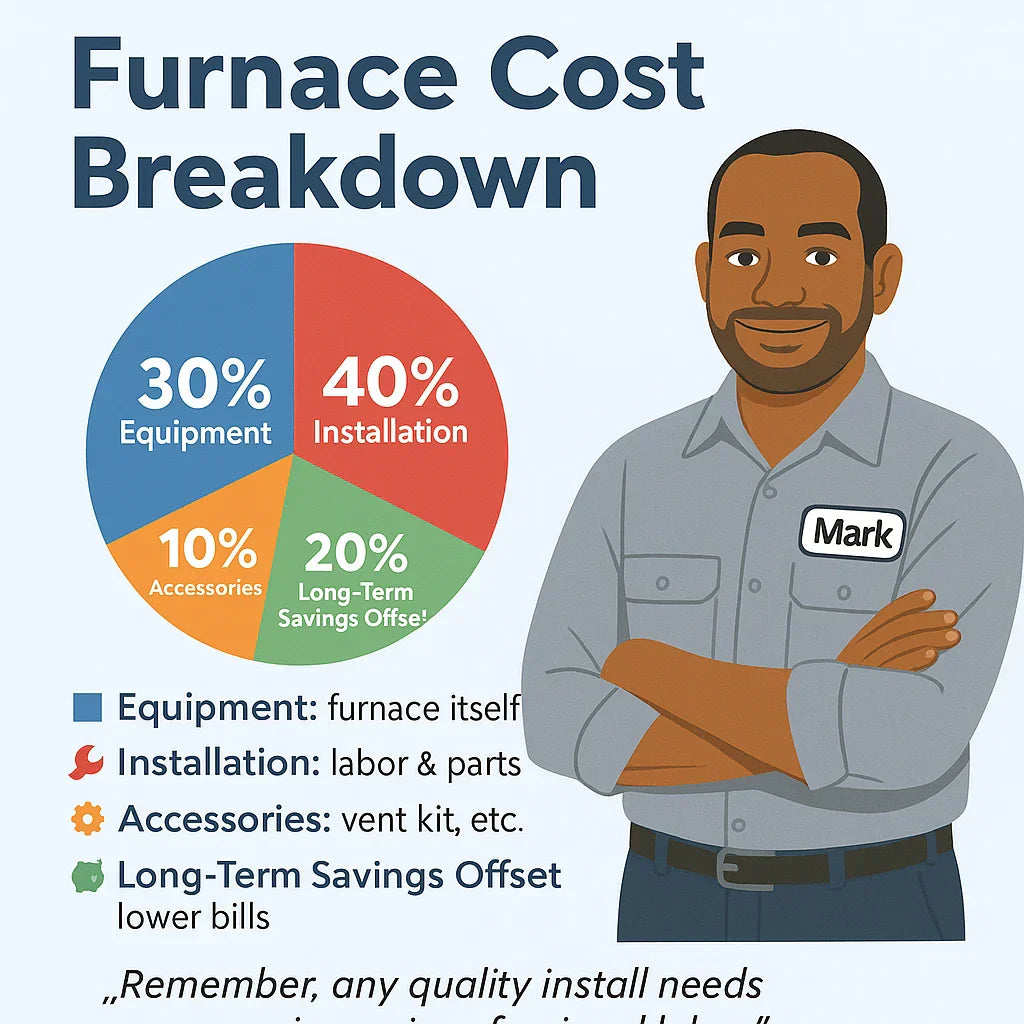🏠 Introduction: The Real Cost of Comfort
If there’s one question I hear more than any other when I’m in a customer’s basement or utility closet, it’s this:
👉 “Mark, how much is this going to cost me?”
And it’s a fair question. Buying a new furnace isn’t like buying a new TV where you just pay the sticker price and walk away. The cost of a furnace involves:
-
The unit itself
-
The labor to install it
-
Accessories and parts to make it safe and code-compliant
-
And of course, the long-term savings you’ll see on your utility bills
When it comes to 40,000 BTU R-32 gas furnaces, the costs can vary depending on your home, your climate, and your efficiency goals. In this guide, I’ll break it all down — just like I do for customers before starting a job.
💰 Equipment Cost: The Furnace Itself
When people shop online, they usually see the furnace price first. But that’s just one part of the puzzle.
📦 Furnace Price Range
For a 40,000 BTU R-32 gas furnace, here’s what you can expect:
-
Standard efficiency (80% AFUE): $1,200 – $1,600
-
High efficiency (90–95% AFUE): $1,600 – $2,200
AFUE = Annual Fuel Utilization Efficiency. It measures how much of the gas you burn actually heats your home.
-
At 80% AFUE, 20 cents of every dollar goes up the vent.
-
At 95% AFUE, only 5 cents of every dollar is wasted.
⚖️ Brand Differences
-
Goodman / Amana: Solid performance, good warranties, affordable.
-
Carrier / Lennox: Often pricier, but with more premium features.
-
York / Rheem: Mid-range pricing, reliable track record.
📖 Reference: ENERGY STAR – Furnaces Product Finder
👉 Mark’s Tip: Don’t chase brand names blindly. Look for efficiency, warranty, and installer reputation first.
🔧 Installation Labor & Accessories
Here’s where the sticker shock sometimes hits homeowners: installation is often more expensive than the furnace itself.
👷 Labor Costs
Professional installation for a 40,000 BTU furnace typically runs:
-
$2,000 – $3,500 depending on complexity and location
That covers:
-
Removal of old furnace
-
Placement and leveling of new unit
-
Connecting gas, vent, electrical, and ductwork
-
Startup, testing, and commissioning
🔩 Accessories That Add to the Bill
No furnace is just “plug and play.” You’ll usually need:
-
Venting kits ($150–$500)
-
Thermostat upgrade ($150–$350 for smart models)
-
Gas shutoff valves & regulators ($50–$200)
-
Condensate pumps or drains (for high-efficiency units, $100–$250)
-
Duct transition pieces ($50–$200)
📖 Reference: Furnace Installation Costs
👉 Mark’s Tip: If your contractor isn’t mentioning accessories, ask. Cutting corners on vent kits or safety valves is a recipe for trouble.
📐 Additional Home Preparation Costs
Every home is different. Some installs are straightforward; others require extra work.
Ductwork
-
Seal & insulate: $500–$1,500
-
Duct replacement/resizing: $2,000+ if badly designed
📖 Reference: DOE – Duct Sealing
Electrical
-
New circuit: $300–$800
-
Thermostat wiring: $150–$300
Gas Line
-
Extension or resizing: $200–$800 depending on distance and piping
Insulation Upgrades
-
Attic insulation: $1,500–$3,000
-
Weatherstripping and sealing: $200–$500
👉 Mark’s Tip: I always tell customers — “Sometimes the cheapest furnace upgrade is actually fixing your insulation.”
📊 Long-Term Savings with R-32
Now here’s where R-32 comes in.
🌍 Efficiency Advantages
-
R-32 refrigerant has higher heat transfer efficiency than R-410A.
-
Systems can be designed smaller and run more efficiently.
💵 Utility Savings
On average, switching from an 80% AFUE R-410A system to a 95% AFUE R-32 system can cut heating bills by 15–25%.
📖 Reference: ENERGY STAR – Energy Savings Calculator
🔧 Service Savings
-
R-32 is a single-component refrigerant, easier to handle and recharge than blended R-410A.
-
This reduces long-term service costs.
🔮 Future-Proofing
-
With R-410A being phased out, its price will rise.
-
R-32 keeps you compliant with 2025 EPA standards.
📖 EPA – Transitioning to Low-GWP Refrigerants
👉 Mark’s Tip: Think beyond this winter. A furnace should last 15–20 years. Don’t saddle yourself with yesterday’s refrigerant.
🏦 Total Installed Cost Range
So let’s put it all together:
-
Equipment (furnace): $1,200 – $2,200
-
Labor: $2,000 – $3,500
-
Accessories: $500 – $1,000
-
Home prep (ducts, wiring, etc.): $500 – $3,000 (varies)
✅ Total Typical Range: $3,700 – $6,700
Add rebates and tax credits, and you may save $500–$1,200.
📖 Reference: DSIRE – Energy Efficiency Incentives
🌍 Why R-32 Lowers Lifetime Cost
Here’s where the numbers really matter:
-
A 95% AFUE R-32 furnace might cost $500–$800 more upfront than an 80% AFUE R-410A model.
-
But over 15 years, it could save $4,000–$6,000 in gas bills.
-
Plus, you avoid the future headaches of servicing a phased-out refrigerant.
👉 That’s why I always say: buy once, cry once. Pay a little more upfront, and it pays you back every winter.
🏆 Mark’s Take: The Smart Way to Budget
When I sit at a kitchen table with a homeowner and break down the numbers, here’s what I tell them:
-
Don’t just shop for the lowest sticker price.
-
Ask about installation quality, accessories, and long-term fuel savings.
-
Look at the 15-year cost, not just year one.
A 40,000 BTU R-32 furnace is one of the best investments for smaller homes because it balances:
-
Affordability
-
Efficiency
-
Future-proof design
🎨 Infographic Idea: “Where Your Furnace Dollars Go”
Pie chart with segments:
-
Equipment (30%)
-
Labor (40%)
-
Accessories (10%)
-
Long-term savings offset (20%)
With Mark explaining each slice in plain language.
In the next topic we will know more about: Maintenance Tips to Keep Your 40,000 BTU Furnace Running Smooth







